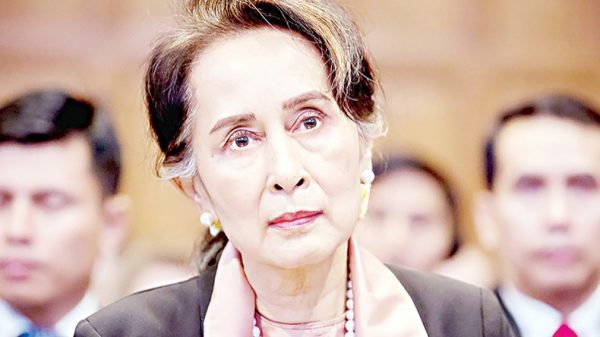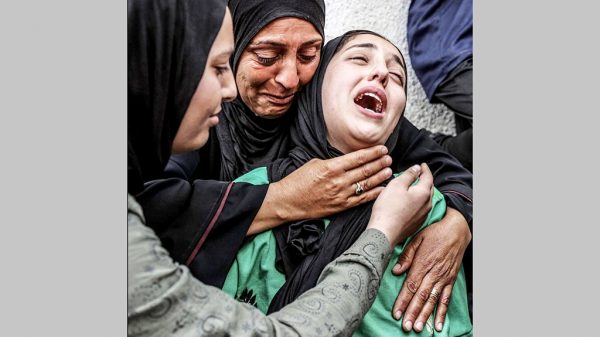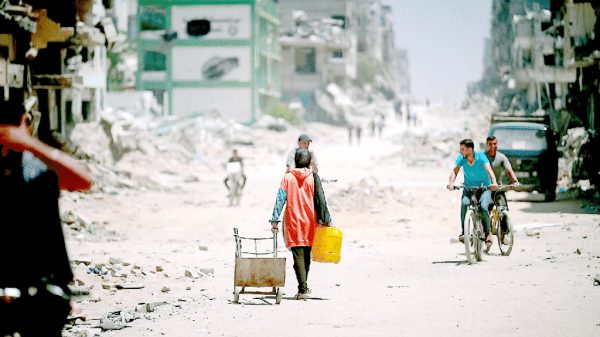Suu Kyi’s claims at ICJ

ON A chilly morning of December 11, 2019 in the Hague, Nobel peace prize laureate Aung San Suu Kyi stood before the International Court of Justice to defend her country from charges of genocide. Suu Kyi stated, ‘Currently, an internal armed conflict is going on there — between the Arakan army, an organised Buddhist armed group with more than 5,000 fighters, and the regular Myanmar Defence Services. None of the speakers yesterday made any reference to this.
‘The Arakan Army seeks autonomy or independence for Rakhine — or Arakan as it was called — finding inspiration in the memory of the historic kingdom of Arakan.
‘When Britain made Burma a colonial entity separate from British India in 1937, the border between Burma and India was drawn along the river Naf, where we find today’s border between Bangladesh and Myanmar. The historical kingdom of Arakan had extended much further to the north than the river Naf, including most of what is today Chittagong district in Bangladesh.
‘Members of some Rakhine communities, therefore, felt that the border drawn by the British was too far south; others, that it was too far north. Myanmar has never challenged this border since independence in 1948.’
However, she did not mention that the border of Arakan kingdom was also too far south, which was lost by the invasion of Burmese king Bodawpaya in 1784–85.
Suu Kyi wrote in her book Freedom from Fear, ‘The Arakan on the western coast of Burma have a long history which can be compared with that of Mons and the Burmese. However, because the area is cut off from the rest of Burma by the Arakan Yoma, the Arakanese have not been so closely involved in the wars of the other two peoples. Powerful kings from central Burma have made their authority felt in Arakan, invading it and demanding tribute. But it was only in the eighteenth century that it was annexed to the Burmese kingdom by King Bodawpaya.’
She did not want to inform the international community of the reason behind Bodawpaya’s invasion of the kingdom of Arakan. Not some Rakhine communities, but many Rakhines communities hardly believe that the Burmese govern them; but they strongly feel that they are colonised.
The last independent kingdom of Arakan, after thriving for more than 350 years as a prosperous trading hub, came under the Burmese control in 1784. By the late 18th century, the Burmese had developed a sense of proto-nationalism with a common language, a common religion, and a common set of legal and political ideas and institutions; even a shared written history existed throughout the core area of the Ava kingdom, from Upper Burma to Mandalay. Consolidated and unified, the Ava kingdom enjoyed unprecedented power internally and externally and, by the turn of the 19th century, the court of Ava could claim a series of spectacular successes on the battlefield. It was as part of this expansionist campaign towards the western front that the annexation of Arakan took place.
This annexation was, indeed, a massive operation, conducted under the command of the crown prince, with three land forces of 13,706 armed men, 1,103 horsemen, 5,804 gunners, 300 cannons, 8,412 visses of gun powder, and 41,686 cannonballs as well as a naval force of 1,848 gunners, 4,396 armed men, 165 boats carrying cannons, 633 cannons, 41,400 cannon balls, 769,500 gunshots and 16,185 flints. Political prisoners and criminals were also sent along with the regular forces. On January 20, 1785, the Arakanese capital city was taken and its king and many of his followers were captured. As soon as the victory was reported to the Burmese king, he ordered a great celebration on January 26, 1785 to mark this triumph over Arakan.
The war against Arakan was officially conceived as a religious war — a mission to re-establish Buddhism in Arakan. Since the influence of Buddhism was waning in Arakan, the now-powerful Buddhist kingdom of Ava took on the responsibility for re-establishing Buddhism in the region. Like many imperial powers throughout history that have brought historic artefacts to their centres of power as a physical demonstration of authority and as part of the official narrative of a glorious past and its revival under their leadership, the Burmese king moved Mahamuni, the iconic great image of Buddha, from Kyauktaw in north Arakan to Amarapura, the capital of Ava, now in Mandalay. A royal order of Burma dated October 16, 1784 makes the point clear: ‘[The] crown prince shall march as commander-in-chief of Arakan campaign to restore proper conditions in Arakan for the prosperity of the Buddha’s Religion.’
Although instructions on the conduct of Burmese forces in this campaign prohibited the forcible taking of any young women or taking anything from the local people without payment, the crown prince was explicitly instructed to ‘clear the place of all bad characters’ so that Buddhism might prosper again in Arakan. A series of Buddhist missions were also sent to Arakan following the annexation with the task of re-Buddhicising the area and local authorities were repeatedly ordered to extend full support to these missions so that they could build ordination halls at places of their choice. Various other political changes were also imposed. A royal order of October 14, 1787 clarified that since Arakan was now part of the Burmese kingdom, the people of Arakan must not continue using their former seals and coins. Another royal order issued in February 1789 mentioned that members of the Arakan royal family had to live in the south of Kyauktawgyi palace. The king and his close family had been captured soon after the conquest of the capital on January 3, 1785. According to the royal order issued on January 2, 1788, together with the royal family, Brahmins, and astrologers, artists and soldiers were brought as prisoners to Burma sometime after the conquest.
Many Arakanese left their home country in 1794 and 1797–98 as a consequence of the Burmese policy of systematic deportation. According to G Harvey and H Burney, there were 250,000 Arakanese in the time of the conquest and Arakan steadily lost up to 50 per cent of its population. English observers estimated the Arakanese population at about 100,000 at the time of the British conquest.
The history of the independent kingdom of Arakan came to an end by the invasion and occupation of Burmese king Bodawpaya in 1784. After 40 years of the Burmese rule, the British colonialist annexed Arakan to the British India during the first Anglo-Burma war of 1824 and it had remained under British administration till Burmese independence on January 4, 1948.
The British colonial power transferred the sovereignty of Arakan on January 4, 1948 into the newly formed ‘Union of Burma’ without consulting the people of Arakan. The concept of ‘Union of Burma’, which was invented by the colonialists and based on the sanctity of the illegal boundaries of the colonial empire, was established by conquests. It is a state that is based on conquered territories without reference to the conquered peoples, their cultures, languages, histories, identities and inalienable rights. The Union of Burma is, thus, admittedly a state based solely on British colonialism — without decolonisation. Hence, Arakan became un-decolonised and non-self-governing territory.
The Oxford English Dictionary defines decolonisation as ‘the withdrawal from its colonies of a colonial power; the acquisition of political or economic independence by such colonies.’ The term refers particularly to the dismantlement. However, decolonisation not only refers to the complete ‘removal of the domination of non-indigenous forces’ within the geographical space and different institutions of the colonised, but it also refers to the ‘decolonising of the mind’ from the coloniser’s ideas that made the colonised inferior.
The Britishers violated this principle of separate juridical status of colonial territories, when they transferred their legal ‘sovereignty’ over Arakan to the Burma union.
There can be no compromise between the concept of ‘Union of Burma’ and the principle of ‘decolonisation’, because one goes directly against the other. Decolonisation requires ‘liquidation of all colonial empire’ with specific steps and definitive procedures, but the Union of Burma exists on the principle of the total preservation of the territorial integrity of the previous colonial empire; an empire is not liquidated if its integrity is preserved. The ‘Union of Burma’ is still an un-liquidated and un-decolonised colonial empire with the Burmese replacing the Britishers as the colonial masters.
In addition, there is no legality and judicial values of the treaty on the transfer of ‘sovereignty’ between British and Burma signed on October 7, 1947, especially concerning the transfer of ‘sovereignty’ over Arakan to Burma for the following reasons:
— The glaring incompatibility of the treaty with the decolonisation principles of the UN that had been imposed universally.
— This treaty clearly violated the right to self-determination of the people of Arakan.
— The treaty was neither signed by any representative of the people of Arakan nor given mandate from them.
— The power and authority of the people of Arakan was arbitrarily ignored in the treaty.
— The transfer took place without consulting the people of Arakan through a plebiscite or referendum, and doing it outside all established procedures of the United Nations Decolonisation Law and precedents set up by the International Court of Justice.
It is an irony of fate that the portion of time preceding Burmese independence was a very dark period for the people of Arakan. The people of Arakan hardly believe that the Burmese govern them; but they strongly feel that they are colonised. After being integrated into Burma, the people of Arakan have been a part of a unitary state of the Union of Burma during which they have been subjected to brutal and inhuman treatment such as; human rights abuses, killings, rapes, ignorance, poverty and social injustice and have been subjected to virtual ethnic and cultural genocide.
Aman Ullah is a freelance writer and researcher on Rohingya, Arakan and Myanmar.




























Leave a Reply